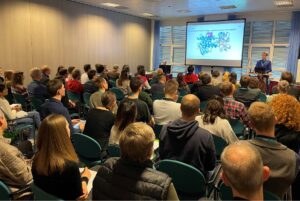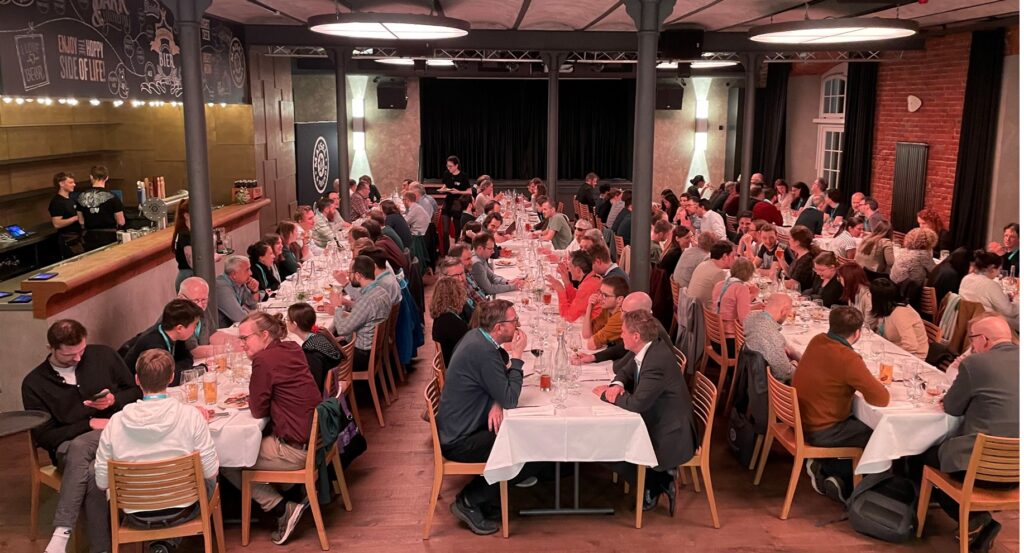Written by Prof. Dr. Dr. h.c. Natalia Dubrovinskaia
Dear Colleagues,
As Chair of the 32nd Annual Meeting of the German Crystallographic Society (DGK), I am pleased to share with you my impressions of the recent event and the experiences gathered by me and the other two members of the local organizing committee (Prof. Dr. Sander van Smaalen, Laboratory of Crystallography, University of Bayreuth, and Prof. Dr. Dr. h.c. Leonid Dubrovinsky, Bavarian Geoinstitute, Research Institute for Experimental Geochemistry and Geophysics, University of Bayreuth). Between March 18 and 21, 2024, we welcomed 288 crystallographers from Germany and 13 other countries to Bayreuth.

The many facets of crystallography were covered in 28 specialized sessions (microsymposia), including a “Lightning Talks” symposium focused on the research of early-career crystallographers, and an “Oral Posters” symposium that gave presenters the chance to summarize selected posters in five-minute talks (Fig. 1). In total, 136 talks were given, including 26 Lightning Talks and Oral Poster presentations, plus four plenary lectures. A further 107 scientific contributions were displayed as posters. An accompanying industrial exhibition provided insight into the latest instrumentation and software for crystallographers.
The plenary lectures were the highlights of the conference. Our speakers are world-leading specialists in various subfields of crystallography: Prof. Dr. Randy John Read (AlphaFold in structural biology) from the University of Cambridge, Cambridge Institute for Medical Research (UK); Dr. Marc de Boissieu (aperiodic crystals) from Université Grenoble Alpes, CNRS, Grenoble INP (France); and Dr. Eugenia Peresypkina (supramolecular crystallography) and Prof. Dr. Maxim Bykov (high-pressure crystallography), both from Goethe University Frankfurt, Institute of Inorganic and Analytical Chemistry (Germany).


The local organizing committee did its utmost to implement modern standards for the DGK Annual Meeting 2024 in Bayreuth. In contrast to earlier DGK conferences held on university campuses, the 32nd DGK Meeting took place in a dedicated conference hotel (ARVENA Kongress Hotel Bayreuth), so that accommodation and the venue were all under one roof. We also set the conference start time to 2:00 p.m., an hour later than in previous years. All of this contributed to the best-attended opening ceremony ever (Fig. 2). Lunches were provided on-site (included in the conference fee), fostering uninterrupted discussions and expanding networking opportunities beyond the microsymposium rooms (Fig. 3), creating a truly collegial atmosphere among crystallographers (Fig. 4). This was greatly appreciated by attendees both on-site and in their post-conference feedback.

The social evening at the famous Bayreuth restaurant “Liebesbier” (Fig. 5) offered a delightful time in a cozy atmosphere, featuring delicious food and the city’s widest selection of beers.
The meeting schedule was a key organizational point. After thorough discussion, the local committee adopted a “1×30 + 3×20” format for all microsymposia running in four parallel sessions. This meant that of the four scheduled talks in each session, one invited lecture ran 30 minutes and three regular talks ran 20 minutes each. With all sessions held concurrently, attendees could easily follow their own program without missing any presentations in different microsymposia.

A conference photo session was introduced in Bayreuth for the first time (Fig. 6).
In summary, the DGK Meeting 2024 served as an invaluable platform for the exchange of knowledge, the sharing of ideas, and the fostering of collaborations within the vibrant crystallography community. I am confident that it not only inspired new discoveries and developments in our field but also deepened our understanding of the world. The insightful contributions of every participant will undoubtedly have a collective impact on the advancement of crystallographic research—a progress I look forward to learning more about at DGK 2025 next year.

With kind regards,
Prof. Dr. Dr. h.c. Natalia Dubrovinskaia
Chair, 32nd DGK Annual Meeting 2024
University of Bayreuth, Laboratory of Crystallography, Material Physics and Technology at Extreme Conditions
